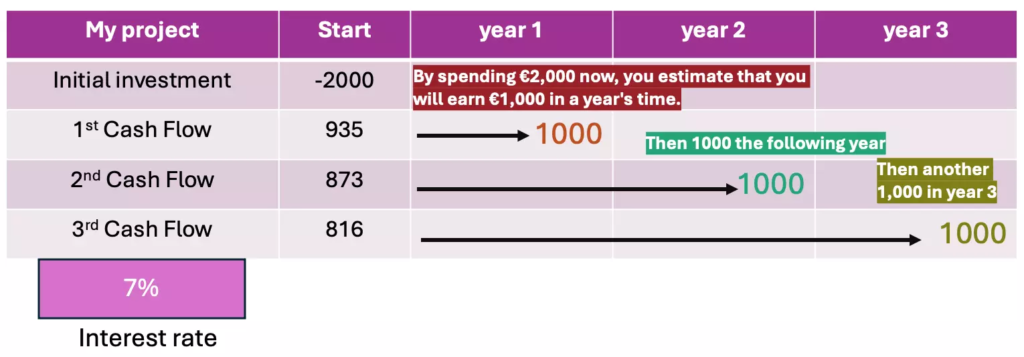The French startup ecosystem continues to create jobs, with 4% growth in the first half of 2024. While hiring remains strong (+17%), a rise in layoffs in June calls for
Valuing a start-up is a crucial stage in your strategic development.
GOWeeZ will help you review your calculation methods. In this article, we look at the DCF ( Discounted Cash Flow) method.
There are various principles for valuing start-ups, which are identified and used according to a number of factors.
The Discounted Cash Flow (DCF) method is one of the most robust and widely used methods for valuing a company.
Here is a detailed guide to understanding and applying this method.

The DCF method is based on the principle of financial forecasting.
It is based on the principle that the value of a company is equal to the sum of the future cash flows it will generate. Cash flows discounted to present value.
This involves projecting the company’s expected future cash flows and discounting them using an appropriate rate of return.
Financial analysts use DCFs or discounted cash flows to determine the value of an investment today. In other words, they use projections of how much that investment will generate in the future.
Discounted cash flow analysis determines the present value of expected future cash flows using a discount rate.
So, discounted cash flow analysis allows us to estimate the money an investor could receive from an investment, adjusted for the time value of money.
The time value of money assumes that a euro you have today is worth more than a euro you will receive tomorrow because it can be invested.
In simple terms, assuming an annual interest rate of 5%, 1000 euros placed in a savings account will be worth 1050 dollars in a year’s time. Similarly, if a payment of €1,000 is delayed by a year, its present value is €950 because you cannot transfer it to your savings account to earn interest.
As you can see, time and risk come at a cost:
“Having €1,000 in a year’s time is equivalent to having how much now?”

How the Discount Rate is calculated or WACC (Weighted Average Cost of Capital).
The discount rate reflects the weighted average cost of capital (WACC), which takes into account the cost of equity and the cost of debt. It reflects a profitability requirement.
Projected Cash Flow (A)

On the other hand, if you start from the future to discount a cash flow, the formula is as follows:
Discounted Cash Flow (B)
I start from the future and work my way back to the present

For unlisted companies, the cost of equity is often estimated to be higher than for a listed company in the same sector. This is because there is a risk of illiquidity, which equates to a higher risk premium.
WACC is expressed as a percentage.
For example, investors would like to see a return on equity of 15% –> this is the expected ROE (Return on Equity).
To do this, we need 3 things to calculate the WACC:
Let’s take the example of 60/40 (60 for equity, 40 for debt).
Equity costs me 60 x 15% = 9
The figure 9 is used to calculate the net profit, which means that shareholders are expecting a profit of 9. We expect a profit of €9 for an investment of €60.
Net debt costs me 40 x 15% = 1.2 (which we give to the bank).
The formula is as follows:
60+40 = 100 (capital invested or total resources). We need to take out 1.2 for financial costs net of tax and 9 for profit at the end of the year.
So for everyone to be happy, we need a total of 10.2 in economic profit.
We therefore need to generate a profit of 10.2 for a margin on capital employed of 100%, so the WACC will be equal to 10.2%.
The WACC is the ROCE (Return On Capital Employed) target that we need to achieve to keep everyone happy! (perfect balance, Bank and Shareholders)
ROCE is a very important ratio to consider when analysing the financial performance of a company or project. Its purpose is to measure a company’s ability to generate profit in relation to the capital invested.
The WACC can also be calculated as follows:

Any resemblance to an existing company is purely coincidental.
Let’s take this example of a WACC of 10.2% and an initial investment of €1m.
In addition, let’s assume a growth rate of 3% per year and a cash flow of €1 million each year.
The projected cash flow (A) is therefore €1,030,000 in year 1.

As a result, the terminal value at this stage is not discounted, so we need to proceed as follows using this formula
Discounted Terminal Value = LT / (1+WACC)⁵ = 16,584,956 / (1+0.102)⁵ = €10,272,144
So, if we add up all the discounted cash flows, Discounted Cash Flow (B), we have :
A word of warning about this calculation method, which remains a financial mathematical demonstration. Notions such as Good Will or Bad Leaving are not taken into account.
In addition, associated risks of all kinds and factors linked to future growth must also be taken into account.
Very often, when companies are acquired, external costs are identified, such as the management earn-out or the integration of assets and technologies.
Due-diligence enables us to look at all of this calmly, so that we can fine-tune the valuation and the negotiations to follow.
Finally, the context, the sector and the ability to keep key personnel motivated are also factors to be taken into account.
When it comes to M&A, every weak signal is part of the equation.
At GOWeeZ, We work with investors such as family offices who are interested in innovative growth projects.
If you would like to present your project :
you can submit it to MY PITCH IS GOOD
or directly on GOWEEZ sur la page Venture
Other articles on investment and entrepreneurship that might interest you:
The comparable method, one of several methods for calculating start-up valuations
Family offices and investment for wealthy families.
What factors need to be taken into account when choosing the right investment fund?
Advisor et Consultant auprès des dirigeants d'entreprise - Président de GOWeeZ. et fondateur de MY PITCH IS GOOD !
The Discounted Flash Flow (DCF) method involves valuing a start-up by taking into account the company's discounted cash flows over a period of time. The discounted cash flow (DCF) method is one of the most robust and widely used methods for valuing a company.
Fabrice Clément Tweet
Goweez © 2025